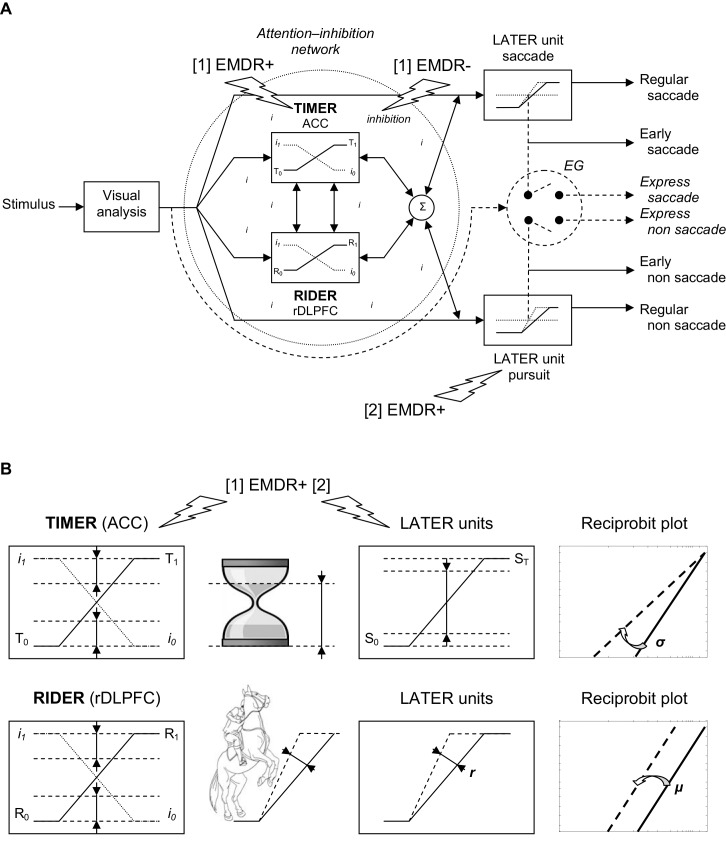Figure 2.
(A) TIMER/RIDER model. Visual information from the two retinas is analyzed to determine the spatial location of the stimulus. Excitatory mechanisms (right). Once the decision is made to elicit an eye movement toward the stimulus, decision signals initiate in LATER units for saccade and non saccade, which rise at a constant rate to reach the threshold at which regular or early saccade and/or non saccade are triggered. In LATER units, the thresholds and/or the rates of rise for saccade and non saccade can differ. Inhibitory mechanisms (dotted circle). In a global attention-inhibition network, the inhibition process has value between I1 and I0 throughout the network. Modulation. Two units modulate excitatory and inhibitory mechanisms: TIMER (Threshold Interval Modulation with Early Release) corresponding to anterior cingulate cortex (ACC) activity, and RIDER (Rate of rIse Deviation with Early Release) corresponding to right dorsolateral prefrontal cortex (rDLPFC) activity. TIMER and RIDER signals increase from respectively values T0 and R0 to values T1 and R1 (full line), causing a mirror decrease in inhibition from I1 to I0 (dotted line). Modulators’ effects are added (σ) producing a change in LATER units in either decision thresholds or in decision gain or in both. In turn, movement-induced LATER activity can stimulate TIMER and RIDER activity and reduce the level of inhibition. Early vs. express triggering (right). Under strong conditions of attention-inhibition release by TIMER/RIDER modulators, LATER units produce short-latency eye movements in the form of early movements. Under optimal conditions of attention-inhibition release, the short visual route bypassing attentional/decisional mechanisms (dashed arrow) elicit express movements in an all or nothing way (switch). (B) Effects of TIMER/RIDER on the inhibition process and on LATER units. An increase in the TIMER signal (T) causes a mirror reduction in the inhibition process I, and a reduction in the distance between initial threshold S0 and final threshold ST of LATER units, resulting in a swivel of the recinormal distribution. TIMER also recalls an hourglass with decreasing distance between the level of sand in its upper part and the baseline of its support. An increase in the RIDER signal (R) also causes a mirror reduction in the inhibition process I, and an increase in the rate of rise r in LATER units, resulting in a shift of the recinormal distribution. RIDER is reminiscent of a horseman spiriting his mount to enhance the slope of the rearing up. (A,B) Eye Movement Desensitization and Reprocessing (EMDR) effects. EMDR may have two actions in parallel: [1] EMDR may boost (+) TIMER modulator and inhibit (−) the inhibition process, resulting in higher decision-making and shortened reaction times; [2] EMDR may boost (+) LATER unit for pursuit and retroactively stimulate TIMER/RIDER activity and reduce the level of inhibition, with a similar result on decision and reaction times.

